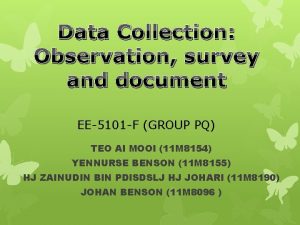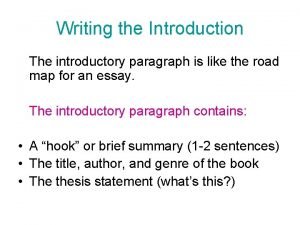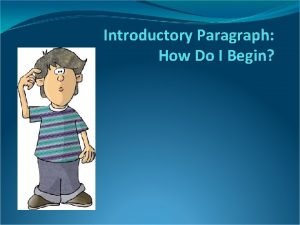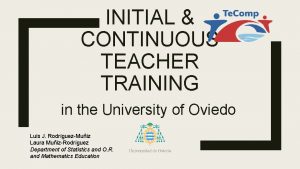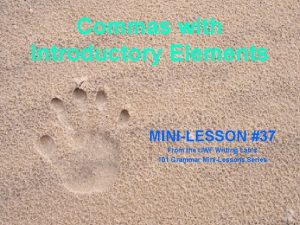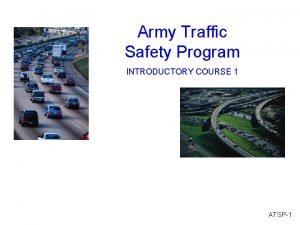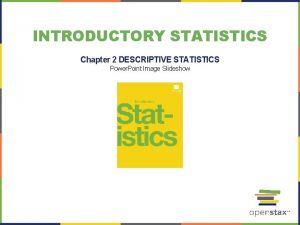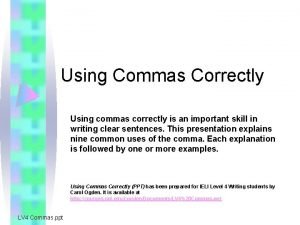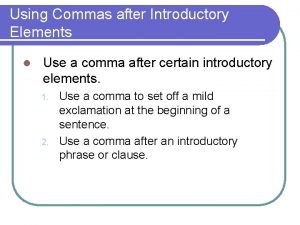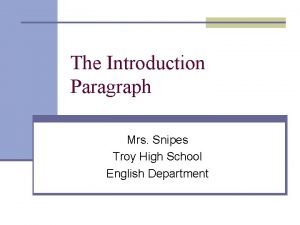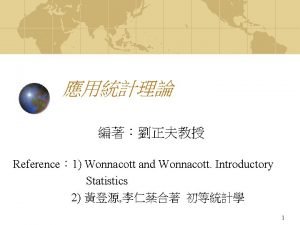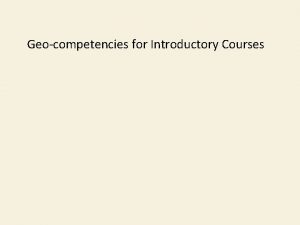EE5101 F INTRODUCTORY EDUCATION RESEARCH h rc a




































- Slides: 36

EE-5101 -F INTRODUCTORY EDUCATION RESEARCH h rc a se e r Group F HJH NURHAFIZAH IZZATI HJ MARALI (11 M 8067) SYAZWINA BINTI HJ MAHMOD (11 M 8068) MAS HANI BINTI MURAH (11 M 8144) DIDINAWATI BINTI HJ ZUNAIDI (11 M 8131) SAFIAH BINTI HJ YAKUP (11 M 8129)

OUTLINES: Title of articles Methodology Purpose of study Participants Data Analysis Definition of Case Study Research Type of Case Study Research How to conduct Case Study Research Strength and Limitation

TITLES OF ARTICLES: Case Study 1 Graphing Calculators and Assessment: A Case Study Author: Jeyaletchumi Case Study 2 The Effectiveness of Peer Instruction and Structured Inquiry on Conceptual Understanding of Force and Motion: A Case Study in Thailand Authors: Decha Suppapittayaporn, Narumon Emarat, and Kwan Arayathanitkul Case Study 3 Allison: A Case Study of Spatial Visualization in Mathematical Problem Solving Author: Ho Siew Yin

TITLES OF ARTICLES: Case Study 4 Using contact with nature, creativity and rituals as a therapeutic medium with children learning difficulties: a case study Author: Ronen Berger Case Study 5 Individualized education program team Decision: A preliminary Study of Conversations, Negotiations and Power Authors: Andrea L. Rupper and Janet S. Gaffney

PURPOSE OF THE STUDIES Case Study 1 • To justify the graphing calculator use is not just limited to calculation purposes only, but also enhances higher order thinking skills. Case Study 2 • To investigate the effectiveness of learning activities on a conceptual change theoretical framework by embedding a peer instruction method with structured inquiry (PISI) on tenth grade students’ understanding of force and motion concepts. Case Study 3 • The roles spatial visualization play as a tool for mathematical reasoning and its processes in problem solving. • Interpretation of the problem solving behavior of a fourth grader, Allison, in her attempts to solve as a set of word problems which is of a non-figural but visually provoking nature.

PURPOSE OF THE STUDIES Case study 4 • To explore the impacts of nature therapy on children with learning difficulties. Case Study 5 • To examine an Individualised Educational Program (IEP) meeting in-depth to understand how the interactions among team members might influence the decision-making process.

METHODOLOGY CS 1 Pre-test items of statistical introduction paper and post-test of improvised same items. CS 2 CS 3 - Pre-test and post-test of using Force Motion Conceptual Evaluation (FMCE) - Intervention using PISI Interviews CS 4 - Open-ended questionnaires - 3 hour interview CS 5 - Observation of the IEP’s meeting Interviews Audio-recording (Meeting & Interviews) Field note

PARTICIPANTS CS 1 Students who enrolled in Introductory Statistics Course, USM, Penang CS 2 -Treatments group (45) - Control Group (54) - Ages between 14 – 15 years old CS 3 - 3 subjects interview of aged 10 in 4 th grade CS 4 - 5 boys and 2 girls between the of aged 8 – 10 years old. CS 5 - 5 year old boy - 11 members of IEP team

DATA ANALYSIS Case Study 1 Emic No participants’ view were recorded or found in the article. Etic perspective: It is the author/researcher’s opinion (from the summary of findings) that the TI-83 Plus graphing calculator can be used for both numerical and graphical procedures. Graphing calculator helps to ensure that a student’s mathematical ability is used to the fullest.

DATA ANALYSIS � Case Study 2 Only test results of students who took both the pre-test � and post-test were used for analysis. The results were collected by looking at: � 1) The mean scores of the pre-test and post-test, 2) The normalized gain to see the effectiveness of the intervention, 3) The Repeated Measures ANOVA to see if the FMCE performance of the two groups are significantly different.

Mean Scores. Vel. Acc. Force 12 3 Overall TI 60. 1 17. 2 3. 12 11. 8 16. 4 PISI 55. 3 17. 9 3. 9 20. 1 17. 7 Force Overall 12 3 Scale Group Vel. Acc. TI 65. 3 33. 6 10. 0 27. 5 28. 4 PISI 71. 3 56. 1 34. 6 69. 9 54. 9 Post-test Group Pre-test Scale

Results from Preliminary Investigation Results from the study

Average Normalized Gain. • • Introduced by Hake (1998) as a way to analyse the effectiveness of a teaching method measured by diagnostic tests such as FCI or FMCE. It is the ratio of an actual average gain and a maximum possible average gain.

<g> Ranges. 0 - 0. 3 : Low Gain 0. 3 - 0. 7 : Medium Gain 0. 7 - 1. 0 : High Gain

Average Normalized Gain. Scale Group Vel. Acc. Force Overall 12 3 TI 0. 13 0. 20 0. 07 0. 18 0. 14 PISI 0. 36 0. 47 0. 32 0. 62 0. 45

Normalized change. • Proposed by Marks and Cummings (2007) to solve the problem of getting negative gain.

Control Group (TI)

Treatment Group (PISI)

Repeated Measures ANOVA. • Use to compare the change running from pre-test to posttest. Scale Vel. Acc. 6. 9 Force Overall 12 3 27. 3 52. 6 47. 4 109. 7 Sig. <0. 01 F

DATA ANALYSIS Case Study 3 Among the three interview subject, Allison was the only child who solved all 8 interview questions successfully. She displayed the characteristics of a ‘visualize’ or ‘geometric ‘type showing the tendency to visualize the problem situation. The interview with Allison revealed salient features in her thinking processes while solving mathematical word problems.

DATA ANALYSIS Characteristics trait is visualizing the problem situation: She does so in her head only for questions that she has encountered in a similar context before. For questions that are new to her, she will visualize through drawing diagrams (detailed or sketchy) on paper to help her think through the problem context. She is able to make the connection between a previously solved problem and transfer the previous solution in the current problem situation.

DATA ANALYSIS Characteristics trait is visualizing the problem situation: The interviewer noticed that Allison always wrote down mathematical statements after already obtaining the solution from the diagram. Bishop (1989) cautioned that a child’s preference for solving problems, whether using visual methods or non-visual ones, may be influenced by the classroom teacher’s problem solving style. Here, Allison learns to conform to her mathematics teacher’s expectation that all solutions should be accompanied by mathematical statements.

DATA ANALYSIS Case Study 4 Routine process logs were taken and analysed in order to check the correlation between specific activities, interactions, elements in nature and the group and individual processes. Data were then analysed and categorised in order to explore the meaning within the overall context of the work. Established principles were used in order to form and support the construction of theory (Mc. Leod, 2002, 2003). After the data were analysed, using Reason’s collective inquiry principles (Mc. Leod, 2002; Reason, 1994), a draft paper was sent to the group facilitators for their reactions which were then integrated in the writing of this article.

DATA ANALYSIS Case Study 5 The field notes reflect thin threads of tentative hypotheses that may represent either emerging patterns or snags that may require further examination. It shows that it is an emic approach because it allows participants and data to 'speak' to the researcher and allow new patterns to emerge.

SIMILARITIES AND DIFFERENCES Similarities METHOD Majority of the articles used interview. Majority of the articles’ PARTICIPANTS participants is small in number. DATA ANALYSIS Majority of the articles used non-computerise analysis. Differences There is the usage of two or more methodologies in one case study. One paper have a large number of participants One paper used computerise statistical analysis.

OUTLINES: Title of articles Methodology Purpose of study Participants Data Analysis Definition of Case Study Research Type of Case Study Research How to conduct Case Study Research Strength and Limitation

CASE STUDY DEFINITION: • Yin (1984): Case study research is an empirical inquiry that investigates a contemporary phenomenon within real-life context. • Gillham (2000): A case study is one which investigates on individual or a community.

TYPES OF CASE STUDY EXPLORATOR Y DESCRIPTIVE EXPLANATOR Y

EXPLORATOR Y Exploratory case studies set to explore any phenomenon in the data which serve as a point of interest to the researchers.

DESCRIPTIVE Descriptive case studies is to describe the natural phenomena which occur within the data in question.

EXPLANATOR Y Explanatory case studies examine the data closely both at a surface and deep level in order to explain the phenomena in the data.

HOW TO CONDUCT CASE STUDY? PLANNING DEVELOP INSTRUMENT TRAIN DATA COLLECTOR IF NECESSARY COLLECT AND ANALYSE DATA Disseminate Findings

STRENGTHS OF CASE STUDY They can help us understand complex interrelationships Case studies facilitate the exploration of the unexpected and unusual Case Studies are grounded in “lived reality”

LIMITATIONS OF CASE STUDY Very expensive, if attempted on a large scale The complexity examined is difficult to be represent simply They do not lend themselves to numerical representation They cannot answer a large number of relevant and appropriate research questions

• Berger, R. (2006). Using contact with nature. Creativity and rituals as a therapeutic medium with children with learning difficulties: a case study. Emotional and Behavioural Difficulties. Vol. 1, 2, 135 -146. • Decha Suppapittayaporn, Narumon Emarat, and Kwan Arayathanitkul (2010). The Effectiveness of Peer Instruction and Structured Inquiry on Conceptual Understanding of Force and Motion: A Case Study in Thailand. Research in Science and Technological Education. Vol. 28 (1), 63 -79. • Gillham, B. (2000). Case Study Research Methods. London: Paston Press Ltd. • Ho Siew Yin (2007). Allison: A Case Study of Spatial Visualization in Mathematical Problem Solving. EARCOME 4, Universiti Sains Malaysia. • Jeyaletchumi (2007). Graphing Calculators and Assessment : A Case Study. EARCOME 4, Universiti Sains Malaysia. • Palena Naela, Shyam Thapa. Preparing A case study: A Guide for Designing and conducting a case study for Evaluation Input. Retrieved on March 11, 2012 from http: //www. pathfind. org/site/Doc. Server/m_e_tool_series_case_study. pdf • Ruppar, A. L. & Gaffney, J. S. (2011). Individualized Education program Team Decisions: A Preliminary Study of Conversations, Negotiations, and Power. Research & Practice for Persons with Severe Disabilities. Vol. 36 (1 -2), 11 -22. • Zaidah Zainal (2007). Case Study as A Research Method. Jurnal Kemanusian. Vol. 9, 1 -5.

THANK YOU FOR LISTENING
 Ee5101
Ee5101 Example of introductory paragraph with thesis statement
Example of introductory paragraph with thesis statement Must not sentences examples
Must not sentences examples Lesson 1-1 variables and expressions answer key
Lesson 1-1 variables and expressions answer key Keeping your hands clean and dry essay
Keeping your hands clean and dry essay Circle kicker journalism
Circle kicker journalism Introductory paragraph examples
Introductory paragraph examples The desert paragraph
The desert paragraph Adverb clause modifies
Adverb clause modifies Www.atlasti.com
Www.atlasti.com Introductory paragraph format
Introductory paragraph format Nominal and adverbial clauses
Nominal and adverbial clauses Introduction title examples
Introduction title examples Introductory chemistry 4th edition
Introductory chemistry 4th edition Prefix multipliers
Prefix multipliers Introductory chemistry 5th edition nivaldo j. tro
Introductory chemistry 5th edition nivaldo j. tro Onedrive uniovi
Onedrive uniovi Introductory paragraph
Introductory paragraph Introductory elements examples
Introductory elements examples Army traffic safety program
Army traffic safety program Numerical
Numerical Anecdote essay introduction
Anecdote essay introduction Chapter 2 descriptive statistics answer key
Chapter 2 descriptive statistics answer key Introductory rite
Introductory rite Introduction paragraph strategies
Introduction paragraph strategies Pivoting paragraph
Pivoting paragraph Middle school introduction paragraph examples
Middle school introduction paragraph examples Introductory adverb clause
Introductory adverb clause Comma introductory clause
Comma introductory clause Introductory phrases and commas
Introductory phrases and commas Comma after introductory phrase
Comma after introductory phrase Snipes troy
Snipes troy Wonnacott and wonnacott introductory statistics pdf
Wonnacott and wonnacott introductory statistics pdf Activity 1 introductory activity
Activity 1 introductory activity Performance review institute inc
Performance review institute inc Seed paragraph
Seed paragraph Nivaldo j. tro introductory chemistry
Nivaldo j. tro introductory chemistry
